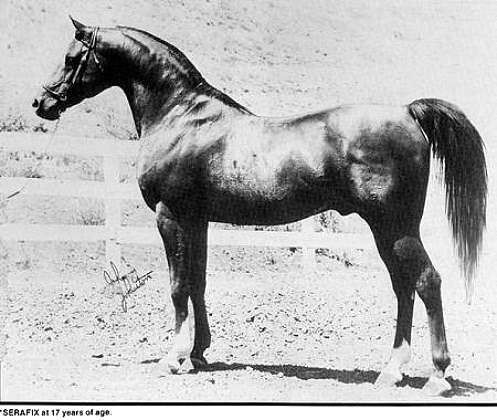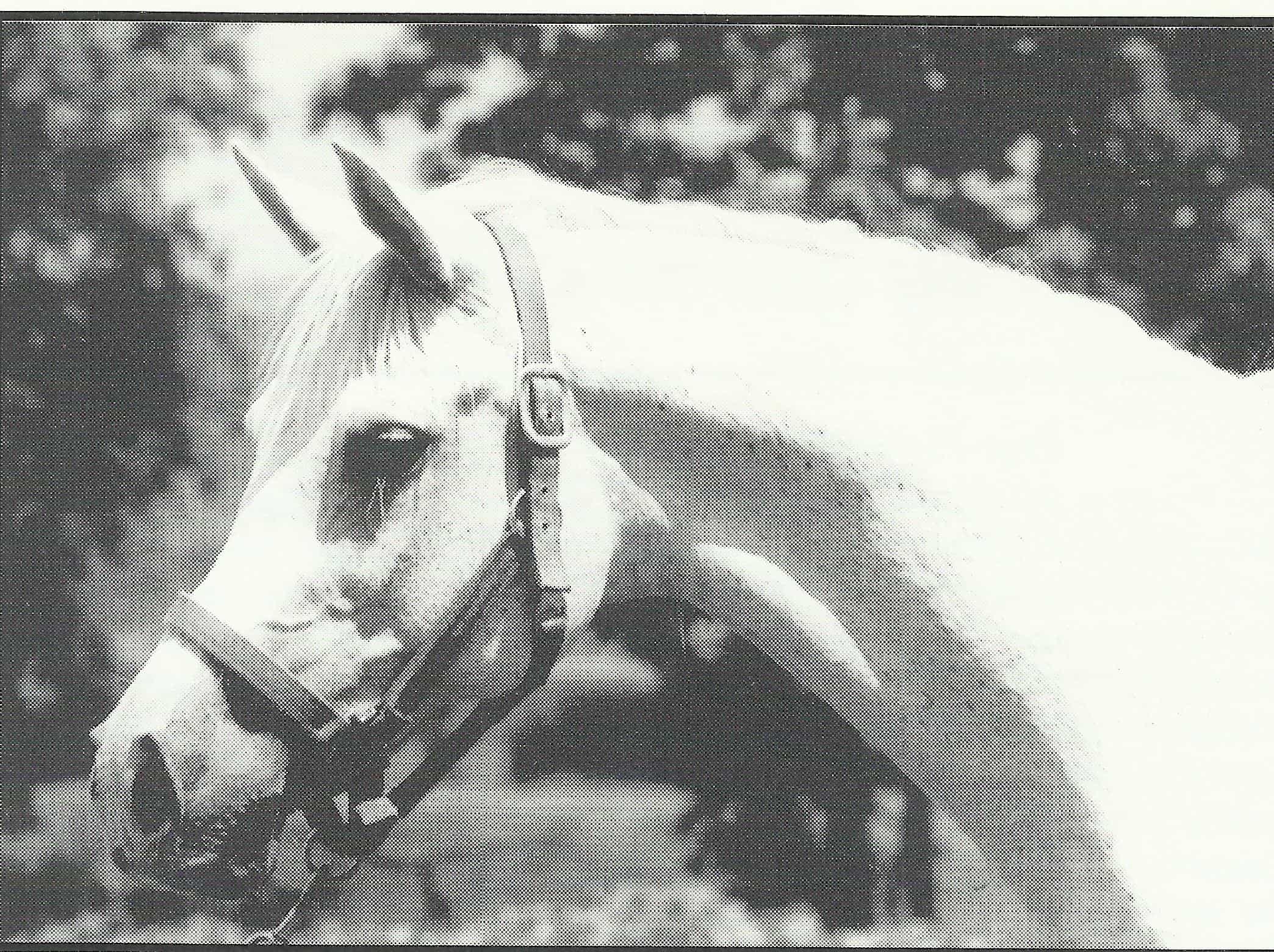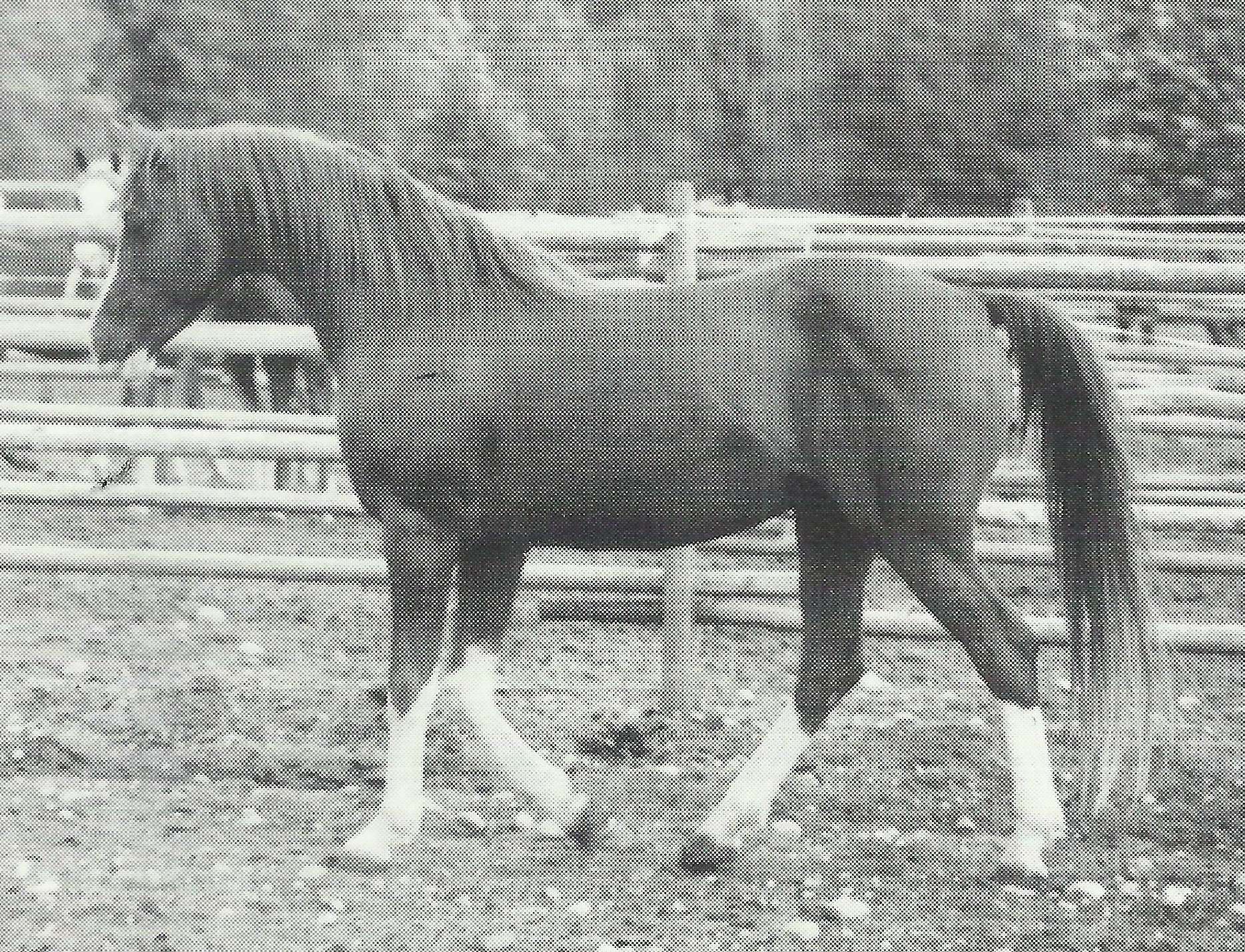By Tara Perry, LAC
Editor's note: Lois Selby Perry is the daughter of Roger Selby one of the early American importers of Arabians from Crabbet Park Stud, most famous of his imports were *Raffles and *Mirage. This interview was written in 2001 for the Eastern Crabbet Arabian Horse Association's directory and Lois gave her friend Barbara Moore, an ECAHS member permission to print it where she saw fit. I thank Buzz Moore, Dee Moore and Barbara for sending the text to me. This may seem a bit rambling although readers will gain interesting insight into Lois's personal recollections.
Most of all I love balance.
` Lois Selby Perry
My horses must look that way and move that way.
I see that as beauty. It's a work of art. It works right.
I grew up with a smoothly muscled, free-moving, beautifully balanced little dynamo named *Raffles. His action was powerful yet easy. He never looked out of sync, standing or moving. I came to know firsthand the symmetry and correctness that expressed both beauty and strength, with a punch that carried through the generations. And oh so classic. He exuded Arabian. It seemed to shout, 'here I am.'
Since my Dad (Roger Selby) imported various family lines from the Crabbet Park breeding program, representing a variety of other body types, with assorted ways of moving, I came to see what worked, and that is what stirred my passion to continue. It was natural for me to continue what was the beginning, although it could not be known then, of a dynasty that permeates the entire Arabian community in America yet today.
*Raffles had the beauty, he had the build, he had the style and he had the potency.
I was fortunate. I started a step ahead, and was grateful for it. But with that gratitude also went the need and the responsibility to be more than just a production factory cranking out the numbers and taking credit for what had gone before.
Two very special horses influenced my vision and the direction this wellspring of *Raffles blood was to take in my life.
The first came while I was still a teenager at home. His name was Shereyn. Among the many visitors who came to the Selby Stud was Chico, California breeder Alice Payne. Her ranch was near the famed Pomona, California Kellogg ranch that had imported *Raseyn and she was thoroughly familiar with and appreciative of the Skowronek legacy. But when she saw *Raffles, that was it. When later my Dad dispersed the herd, she bought *Raffles and converted her entire program to the most intense inbreeding and concentration of *Raffles breeding possible. She not only proved the purity of the blood but provided an invaluable genetic resource pool of breeding stock.
While we were all 'growing up', Alice had this bay son of *Raseyn, Shereyn, that the Paynes used for pleasure, parades, cattle drives, endurance rides, anything. At the worthy age of 14, they put the finishing touches on his career, as a stock horse, winning the World Championship at the Cow Palace against a ring full of 75 top Quarter Horses, a feat almost beyond comprehension in those days. He was called out 14 times in the work-offs and performed perfectly. He had to in order to be recognized at all. Then Alice retired Shereyn and sent him to me in Ohio to enjoy. I learned what that type of build could do. He had a lean, smooth body, moderate in height (15.1), with a legginess. He had a stretch that flowed with energy from head to tail. His structure was so correct, no amount of work ever put a pimple on his legs. Clean, strong, but not heavy boned. His long neck balanced his moves in any direction with ease. That kind of athleticism grabbed me. He was my kind of horse.
The second special horse came along shortly after I was out of college. I had gone to Washington, D.C., to Al-Marah to help found the Arabian Horse Owners Foundation and travel the country promoting it. It was during those travels through Florida that I met Michael, who would confirm and settle the prevailing influence in my life. This amazing bay stallion by the double *Raffles son Raffey out of Abuseyna (Abu Farwa x Daameseyn by *Raseyn) was then in training with Monte Foreman, the foremost western trainer in the country. I rode Michael there and my vision was forever fused into place. It was like riding a cat. He could move and turn and spin with such ease and calm energy you hardly felt him touch the ground. He had that same legginess, a stretch that gave his lean body a sense of readiness for anything. He was so correctly coupled with strong, lean, refined legs and that long balancing neck always moving to keep him centered. Like a prizefighter he moved in any direction with ease. He was the supreme athlete.
Michael and Shereyn's only questionable defect was a lack of dish in the nose bone on an otherwise clean fine head. This was the perfect match with heavily *Raffles bred stock whose gorgeous heads just wouldn't quit.
When I returned to Al-Marah to help with the AHOF clinics and the Arabian racing agenda, Michael became available. I bought him, at that time to use as a racehorse. He had already retired the challenge trophy by winning the 100-mile endurance ride in Florida three times. This ride is one of the toughest in the country with very heavy deep sand and very hot muggy temperatures. The award for this challenging ride is now named the 'Michael Trophy'.
Michael was not only a superb endurance horse, he was fast. As far as I know, he still holds the track record at 2.5 miles (they don't even go that far any more). When he retired from that, at 12 years of age, Monte Foreman asked to have him back to take on tour. Michael won more for Monte in reining in open competition then any horse Monte had ever had. Michael was an athlete, best one I ever knew. He was built that way and proven that way. He was what I wanted in my horses.
By this time I had gotten married and moved to Connecticut to raise horses and a family. Michael came home to retire on welcome open pastures and began his breeding career at Partridge Hollow Park. He had proven the qualities I sought in my horses. I wanted that balance, that look, that feeling. I wanted everything that Michael had, with the classic beauty of intense *Raffles. Who says you can't be a beautiful athlete, anyway?
My selection in that direction was easy in my mind's eye. It wasn't so easy to actually do the selecting. You often give away more than you keep in the stages of going from what you have to what you want to have. So what do you do? Ruthless culling. And by that I do not mean that the horses you are parting with are undesirables. They are simply deviations from what you are striving for. To the onlooker, it may seem that you are giving away better than you keep. But you must keep a clear vision of where you are going, or you will end up somewhere else.
I had sent Shereyn back to Alice when I went away to college and my Dad dispersed the horses. I kept Michael with me until he died at 28. His children are in my bloodlines. Michael was not afield from my breeding by any means but he had a different look. The *Raffles balance was round and compact, whereas Michael's was leaner and more athletic. I loved that about Michael and came to want that in my horses along with the classic *Raffles look. I bred back and forth into the *Raffles lines to attain the balance I was looking for.
My first broodmare, who I bought when Dad dispersed the horses, was Woengran (header photo, pictured at top of page), the dam of Garaff, Bill Munson's herd sire, and Rafden, Dick Lodwick's herd sire, both stallions by *Raffles. While I was traveling around, I farmed her out with Dick, my Ohio buddy, who was also working at being a second-generation breeder. Then when I settled in Connecticut I collected her.
I then bought Rafgida. I had the extreme good fortune to take advantage of perhaps the only weak moment Bill Munson ever had - when he let Rafgida be for sale. He sold her to Xanadu Arabians, and they being more into horse trading than horse breeding, soon made her available. I snapped her up and she became the queen matron of my breeding program.
I then got Azala and Azeda from Jimmie Dean. After leaving the management of the Selby Stud, Jimmie had sent his two old mares Bahia, a *Raseyn daughter, and Weda, by the *Mirage son Agwe out of *Roda, to Azraff to produce two special mares that gave so much to my entire program. Rafgida and Azala both produced dynasties with breeding stallions and mares of like quality.
I bought several mares from Betty Fisher as she retired. Her program was built on breeding daughters of the *Mirage son Image to *Raffles. This was a cross that had proven so successful for Selby Stud. I bought Pharaffa, Phagida and Phaerie Geym.
Then, when Alice Payne died, I had the opportunity to buy her senior sire, the intensely *Raffles inbred Syzygy. He looked very like *Raffles. Gorgeous. Classic. He had the same inner fire yet a calmness that I guess is a confidence in what he is. These provided the nucleus - the very core of my breeding program.
I line-bred, selecting for what I wanted, then inbred it to set the type. Sometimes I would inbreed to the sire and sometimes to the dam. I didn't want to get stuck in one family, breeding myself into a corner for individuals to use, so I selected from multiple family lines of the *Raffles blood. This maintained the gene pool, gave it vigor and potential to express itself as I chose the direction. If I thought I needed to bring in some particular other quality, I 'outcrossed' to another *Raffles family line - or should I say outbred since strictly speaking outcrossing is to another bloodline.
The most fun time is the spring when the foals come. The most difficult time is weeding out the ones that you can't or shouldn't keep. It takes a long time to find the individual that's right enough to breed on with. If I'm not breeding myself better - however small the step - toward the objective, what good am I as a breeder?
I questioned myself many times. I took detours. As something else came along, I had to try it. I was always disappointed. Good as it may have been in its own right, it didn't have the background genetic integrity that I had already instilled in my herd. So it was a detour that wasted my time and I didn't come out with anything I kept.
The quicker you recognize the direction in which you want to move and the sooner you know which cross is moving in that direction, the sooner you make a difference. Even if you are making crosses of animals whose blood you want, you can't just make one mating. It takes at least three of that match because the brothers and sisters vary, and out of that you pick the one that comes closest. If the variation is too much you may not be able to tolerate that match at all in where you are going.
These multi-facets are going on at the same time in your choices. It's a long process of pulling a lot of pieces together at the same time. It takes faith to know that your vision is right for your herd regardless of who the current champions are. If you do not stick to it long enough, like 20 years or more, it's not going to show. It's not going to have your stamp on it. It's not going to speak to your brand with any enduring quality.
That this blood is still thriving speaks to its purity and strength, and to the quality and strength of those committed to it. I am humbled and inspired to see that the horses still not only continue but still look the part. The oldest is gorgeously classic PHP Beguile who at age 31 is retired and thinks she is in heaven with Mary and Ron Andress at Quest Arabians in Pennsylvania. The youngest is this year's filly by Ahmeetz out of FFC L'Orange, a delightfully balanced blend of *Raffles, Michael and old Crabbet. She was foaled at Fairfield Farm under the wise, experienced guidance of Barbara Moore, my long time friend and fellow crusader.
The classics endure in all their ageless glory.
**All of the articles included in the re-launched Crabbet.com site from the original website, Georgia Cheer, Silver Monarch Publishing and The Crabbet Influence magazine are shared here with permission of Georgia Cheer given May 16, 2012.**
Last Updated: March 19th, 2019





Comments
No Comments